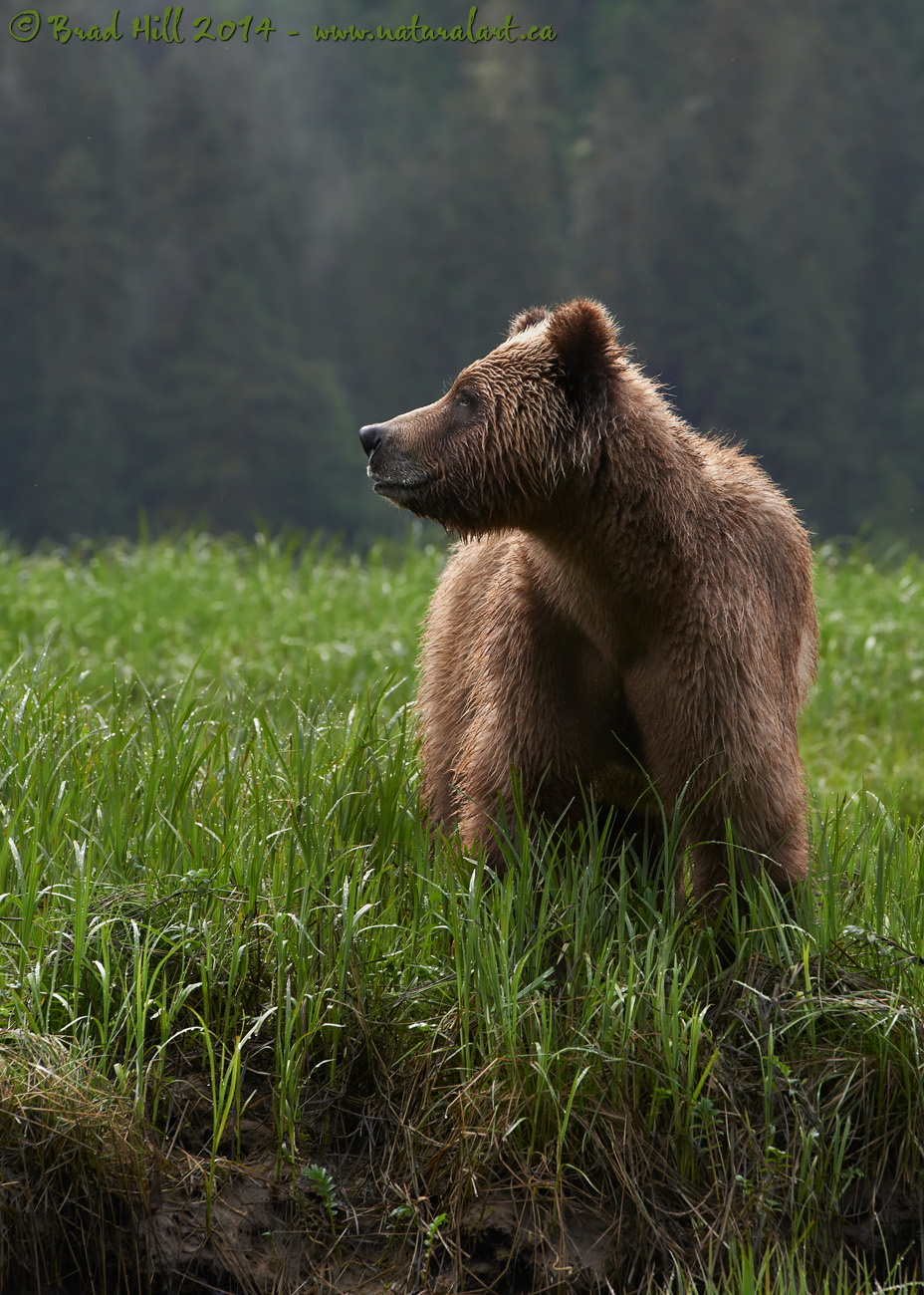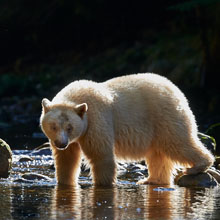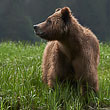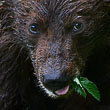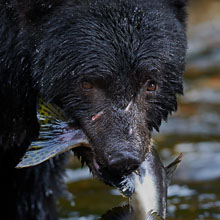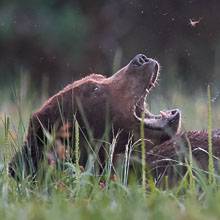Availability: Undetermined - Enquiries?
In the Field
Morning Calm. Khutzeymateen Grizzly Sanctuary (northern Great Bear Rainforest), BC, Canada. May 31, 2012.
Calm bear, calm morning - and some very sweet and very soft light filtering through wispy morning fog - what more can you ask for?
This image was captured early one morning in late May of 2012. At this time of year the grizzlies in the region are still focused on fattening up after their long winter nap and the highly nutritious grasses and sedges growing in the Khutzeymateen estuary draw in (and hold) a large number of bears. Most of the bears quickly work out where they sit in the local social hierarchy and most of the time it's pretty peaceful in the Khutzeymateen. But, even when calm, the bears are always vigilant and on the lookout for bears they don't know and that might be looking to shake up the status quo! And that's how I'd describe this bear - calm, but vigilant (and at the moment this image was captured something in the far distance had drawn her full attention - and it turned out it WAS a "new-to-the-estuary" bear - and one to be concerned about).
I captured this image not too long after I began working with the Nikon D800 and was still getting a feel for how it performed - and what I could (and couldn't) do with it. This shot taught me two things. First, after shooting D3s's and D4's as my "go-to" cameras for wildlife work for quite some time (and with a variety of VR lenses, including super-telephoto lenses) I had got to the point where I knew I could virtually always capture sharp hand-held shots at a shutter speed of 1/focal length of the lens in use (so with a 400mm lens with the VR on I knew I'd get sharp shots close to 100% of the time at a shutter speed of 1/400s). And, although the proportion of sharp shots would decline somewhat, I knew I could often get away with shutter speeds up to 1 stop SLOWER than the 1/focal length rule (so hand-holding a 400mm lens at 1/200s with VR on).
BUT...when I was using the D800 (or - later - the D800e) I ended up with a lot of slightly "soft" shots when hand-holding lenses with that "tried and true" 1/focal length "rule". When I blew THIS shot up to 100% magnification (or 1:1 on the viewing device) the snout of the bear was just ever-so-slightly soft. The minute the shot was brought down to lower resolution (in this case down-sampled from 7130 pixels to 2400 pixels) it looked tack sharp. But for me that's not good enough - I want my shots tack-sharp at 100% resolution and 100% magnification! In time, I learned that the D800/800e is so demanding of technique that it's best to keep it on a tripod whenever possible and, if I must shoot it hand-held, I have to bump the shutter speed UP (to 1/twice focal length) to be assured of tack sharp image captures (the only exception to this is when using the 70-200mm f4 VR, which has a 5-stop VR and it DOES work as advertised - it's amazing!).
The second lesson? This one wasn't learned until February of 2014 when I decided to take this image and play around with one of the new features of Photoshop CC - the "Shake Reduction" filter (Filter>Sharpen>Shake Reduction...). On a lark I ran Shake Reduction on this image and...well...my jaw dropped! The slight softness of the full resolution image (when viewed at 100%) simply disappeared! Like with most Photoshop techniques you have to learn (through trial and error) how to apply the Shake Reduction filter and it IS easy to overdo it. But when used properly Shake Reduction is one sweet feature! I have to say that this filter alone can be worth the price of admission (to Photoshop CC).
This one is pretty sweet in higher resolution form - so here's a 2400 pixel shot for your perusal:
• Morning Calm: Download 2400 pixel image (JPEG: 1.9 MB)
NOTES:
1: This image - in all resolutions - is protected by copyright. I'm fine with personal uses of it (including use as desktop backgrounds or screensavers on your own computer), but unauthorized commercial use of the image is prohibited by law. Thanks in advance for respecting my copyright!
2: Like all wildlife images on this website, the subject is fully wild and completely unconstrained. Besides the potential impact of my presence, nothing has been done to intentionally alter or affect the ongoing behavior of the subject and, of course, there has been no use of any form of bait or other form of wildlife attractants (including vocalizations).
3: This image was captured during a "Grizzlies of the Khutzeymateen" photo tour in the spring of 2012. Each year I offer trips into two different parts of the Great Bear Rainforest as well as one to photograph aquatic mammals and oceanscapes near the northern tip of Vancouver Island. And, in selected years, I also offer photo tours to locations to capture other highly sought-after subjects, such as various boreal owl species and wildlife of Canada's Arctic. Details about these trips can be found on the Photo Tours page of this website.
Behind the Camera
Morning Calm. Khutzeymateen Grizzly Sanctuary (northern Great Bear Rainforest), BC, Canada. May 31, 2012.
Digital Capture; Compressed RAW (NEF) 14-bit format; ISO 1100.
Nikon D800 paired with Nikkor AF-S 70-200mm f2.8 VRII lens @ 200mm. Hand-held; VR on and in "Normal" mode.
1/200s @ f8; -0.33 stop compensation from "recommended" matrix-metered exposure setting.
At the Computer
Morning Calm. Khutzeymateen Grizzly Sanctuary (northern Great Bear Rainforest), BC, Canada. May 31, 2012.
RAW Conversion to 16-bit TIFF, including first-pass/capture sharpening using Capture One Pro version 7. Four raw variants (different versions of a single raw capture) processed, differing by a total of 0.75 stops in exposure.
Further digital corrections on resulting 16-bit TIFF files using Adobe's Photoshop CC. Photoshop adjustments included compositing (blending) of the four output files from the raw converter, further slight exposure adjustments, selective application of the Shake Reduction filter, and sharpening for web output.
Conservation
Morning Calm. Khutzeymateen Grizzly Sanctuary (northern Great Bear Rainforest), BC, Canada. May 31, 2012.
Ten percent of the revenue generated by this image will be donated to Raincoast*.
Species Status in Canada**: Special Concern (May 2002).
While Grizzly Bears (Ursus arctos) are not technically listed as "Endangered" in Canada, they have been extirpated from most of their historical range. Grizzly Bears are far more sensitive to intrusion/disturbance in their habitat than are Black Bears and are being increasingly forced into marginal habitat by human encroachment. The Great Bear Rainforest along the central and northern coast of British Columbia is one of the last strongholds of the Grizzly Bear in Canada, and even this population is coming under increasing pressure.
On December 18, 2017 the government of British Columbia banned grizzly hunting across the entire province. This major conservation victory came after decades of tireless work by many dedicated conservationists and ecologists and, most importantly, it reflects the opinion of the vast majority of British Columbians. And, it means that AT LEAST while the current government remains in power grizzlies are finally "safe" in British Columbia.
Now that we've at least temporarily won the battle to save grizzlies in BC, it's time to re-focus our efforts toward protecting ALL of BC's carnivores, including Gray Wolves, Black Bears, Cougars, Wolverines, and more! Simply put, there are no ecological, economic, or ethical arguments supporting the trophy hunting of carnivores.
In a great first step towards ending the hunting of carnivores throughout BC the Raincoast Conservation Foundation has developed a program designed to protect ALL carnivores within the Great Bear Rainforest. Details about this program can be found on this page on Raincoast's website. Check it out and, better yet, make a donation to help Raincoast purchase the remaining commercial hunting tenures in the Great Bear!
*The Raincoast Conservation Society (and Foundation) is an effective and efficient organization that has been fighting for protection of this unique habitat. If you are looking for a meaningful way to contribute to the conservation of this amazing ecosystem, Raincoast will provide maximal "bang" for your conservation dollars.
**as determined by COSEWIC: The Committee on the Status of Endangered Wildlife in Canada












